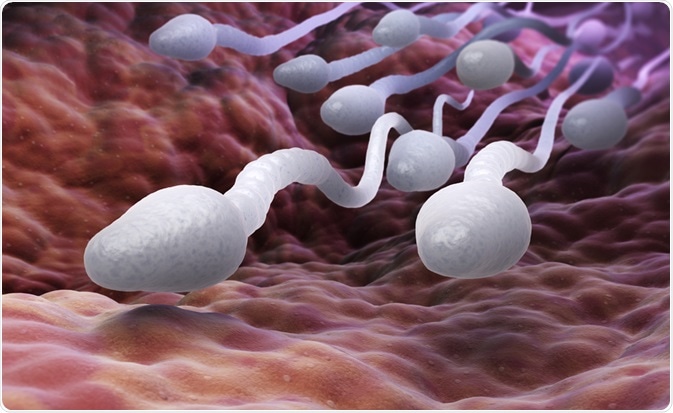Recurrent or repeated miscarriage is defined as the loss of three or more pregnancies before 20 weeks of gestation.
For decades, miscarriage was believed to relate to the woman’s ability to carry a pregnancy to term. However, a recent study has revealed that frequent miscarriages can be associated with poor quality of sperm.

Image Credit: Tatiana Shepeleva/Shutterstock.com
What are the common causative factors of recurrent miscarriages?
Recurrent miscarriages, which affect approximately 1 – 2% of women, are associated with many risk factors. About 60% of miscarriages occur spontaneously due to abnormal chromosomal distribution during fertilization.
Such incidences occur by chance, without any apparent health complications. However, women of higher reproductive age are more susceptible to recurrent miscarriages.
Women with congenital uterine disorders, such as the septate uterus, are also at higher risk of miscarriages. In this disorder, the uterus is partially separated by a wall of tissue, giving rise to two uterine segments.
In addition, certain health complications, such as antiphospholipid syndrome, polycystic ovary syndrome, and diabetes mellitus, can make a woman susceptible to recurrent miscarriages.
Another rare but potential cause of recurrent miscarriages is chromosomal translocation, which is defined as abnormal rearrangement of chromosomes. In such cases, an embryo usually receives a disproportionate number of chromosomes, leading to termination of pregnancy.
Can recurrent miscarriages occur due to a disorder with the man’s sperm?
Despite having known risk factors, the reason behind 50 – 75% of recurrent miscarriages remains unidentified.
To develop appropriate therapeutic interventions to reduce the risk of miscarriage, it is important to identify novel contributing factors.
In this context, a recent study has shown that, compared to healthy couples, women with recurrent miscarriages have male partners whose sperm shows increased levels of DNA damage.
In addition to having a reduction in serum testosterone and estrogen levels, these men have reduced total and progressive sperm motility and atypical sperm morphology. Furthermore, the levels of reactive oxygen species (ROS) in the semen samples of these men are significantly higher than those in healthy counterparts.
The current findings indicate that recurrent miscarriages are not just a female issue; it can also be associated with poor sperm quality. Impaired functioning of the reproductive hormones together with ROS-induced sperm DNA damage can significantly contribute to recurrent miscarriages.
Why is sperm health is important?
In normal physiological conditions, sperm cells produce a low level of ROS (free radicals) to fight against invading microorganisms, such as viruses and bacteria. However, when produced at higher concentrations, these free radicals can cause DNA damage.
Sperm DNA plays an important role in placenta formation, and placental health is crucial for fetal survival. Thus, it is obvious that increased sperm DNA damage can impact pregnancy outcomes by negatively affecting placental health.
Also, a low level of testosterone can negatively impact sperm health by altering spermatogenesis (the process of sperm cell production and development). This can lead to structural and functional abnormalities in sperm, which subsequently can increase the chance of recurrent miscarriages.
What are the frequent sources of ROS in semen?
The two major sites of ROS production in sperm cells are mitochondria and plasma membrane. In addition, leukocytes, macrophages, and abnormal sperm cells produce a substantial amount of ROS.
Production of ROS in sperm cells can be induced by several factors. For example, excessive consumption of alcohol can increase the level of certain metabolites that are responsible for increased ROS production in the mitochondria and sperm plasma membrane. Similarly, smoking can induce ROS production by increasing lipid peroxidation and reducing cellular antioxidant levels.
Another significant reason for increased ROS production is varicocele, which is defined as an enlargement of the veins in the scrotum. Men with varicocele have higher numbers of sperms with chromatin-related abnormalities, which can be due to increased ROS-induced oxidative stress.
Bacterial or viral infections in the male reproductive tract can increase the production of ROS. Studies have shown that the rate of miscarriages after in vitro fertilization (IVF) is higher in women whose male partners have experienced genitourinary infections. Such infections can reduce sperm density and motility, as well as change sperm morphology.
Obesity is considered an important trigger of ROS production in sperm cells, which is most probably due to an increased rate of metabolism. The high level of ROS in obese men can impair spermatogenesis, leading to deterioration in sperm quality. Similarly, diabetic patients have elevated ROS levels in the semen, which can cause sperm DNA damage.
Aging is another important factor associated with increased ROS production and reduced antioxidant capacity. The resultant oxidative stress can impair sperm DNA integrity, leading to the production of poor-quality sperm.
Certain environmental factors, such as air pollutants, can increase ROS production in sperm cells, which can subsequently reduce sperm quality and quantity. In addition, radiofrequency electromagnetic radiation is known to alter sperm viability and motility by increasing ROS production.
Sources
- ACOG. 2016. Repeated miscarriages. www.acog.org/Patients/FAQs/Repeated-Miscarriages?IsMobileSet=false
- Science Daily. 2019. Recurrent miscarriage linked to faulty sperm. https://www.sciencedaily.com/releases/2019/01/190104103950.htm
- Jayasena CN. 2019. Reduced Testicular Steroidogenesis and Increased Semen Oxidative Stress in Male Partners as Novel Markers of Recurrent Miscarriage. Clinical Chemistry.https://academic.oup.com/clinchem/article/65/1/161/5607916
- Sabeti P. 2016. Etiologies of sperm oxidative stress. International Journal of Reproductive Biomedicine. https://www.ncbi.nlm.nih.gov/pmc/articles/PMC4918773/
Further Reading
- All Pregnancy Content
- Early Signs of Pregnancy
- Is it Safe to Exercise During Pregnancy?
- Pregnancy: 0-8 weeks
- Pregnancy: 9 – 12 weeks
Last Updated: Apr 14, 2020

Written by
Dr. Sanchari Sinha Dutta
Dr. Sanchari Sinha Dutta is a science communicator who believes in spreading the power of science in every corner of the world. She has a Bachelor of Science (B.Sc.) degree and a Master's of Science (M.Sc.) in biology and human physiology. Following her Master's degree, Sanchari went on to study a Ph.D. in human physiology. She has authored more than 10 original research articles, all of which have been published in world renowned international journals.
Source: Read Full Article






